Research on Sustainable Design of Consumers’ Influence Factors of Huaihe Willow Weaving Based on AHP
Abstract
1. Introduction
2. Study Framework
2.1. Theoretical Hypotheses
2.2. Research Framework
3. Methodology
3.1. Data Collection
3.2. Sampling Method
3.3. Research Method
4. Results and Discussion
4.1. AHP Structure Model Analysis
4.2. Sustainable AHP Design and Analysis
4.3. The Sustainable Analysis
4.3.1. The Sustainable Key Factor Innovation Discussion
4.3.2. Cultural Value-Added Innovation Discussion
4.3.3. Urgent Demand Analysis of the New Willow—Woven Categories
4.3.4. Integration Analysis of Wicker Weaving Process and New Technology
4.4. The Sustainability Improved Measurement
4.4.1. Cultural Sustainable Innovation Strategy
4.4.2. LCA-Sustainability Development Strategy
4.4.3. New Process Improvement Strategy
4.4.4. Digital Design Strategy
5. Conclusions
Author Contributions
Funding
Institutional Review Board Statement
Informed Consent Statement
Data Availability Statement
Conflicts of Interest
References
- Global Footprint Network. Has Humanity’s Ecological Footprint Reached Its Peak. 2018. Available online: https://www.footprintnetwork.org (accessed on 9 April 2018).
- Grooten, M.; Almond, R.E.A. (Eds.) Living Planet Report-2018: Aiming Higher; WWF: Gland, Switzerland, 2018. [Google Scholar]
- Wang, Y.-K.; Guo, J.-X. The relationship between economy and environment in sustainable development. Sci. Technol. Innov. Appl. 2016, 177, 48–49. [Google Scholar]
- Wan, H.Y. Study on the Impact of Social Capital on Sustainable Development of Economic Environment. Ph.D. Thesis, Jiangxi University of Finance and Economics, Nanchang, China, 2017; pp. 12–25. [Google Scholar]
- Almond, R.E.A.; Grooten, M.; Petersen, T. (Eds.) Living Planet Report 2020-Bending the Curve of Biodiversity Loss; WWF: Gland, Switzerland, 2020. [Google Scholar]
- Pata, U.K.; Yilanci, V. Investigating the persistence of shocks on the ecological balance: Evidence from G10 and N1 1 countries. Sustain. Prod. Consum. 2021, 28, 624–636. [Google Scholar] [CrossRef]
- Wang, H.; Hu, Y. On ecological ethics, environmental ethics and sustainable economic development. Spec. Zone Econ. 2010, 5, 272–273. [Google Scholar]
- Pata, U.K.; Kartal, M.T.; Erdogan, S.; Sarkodie, S.A. The role of renewable and nuclear energy R&D expenditures and income on environmental quality in Germany: Scrutinizing the EKC and LCC hypotheses with smooth structural changes. Appl. Energy 2023, 342, 121138. [Google Scholar]
- Ali, U.; Guo, Q.; Kartal, M.T.; Nurgazina, Z.; Khan, Z.A.; Sharif, A. The impact of renewable and non-renewable energy consumption on carbon emission intensity in China: Fresh evidence from novel dynamic ARDL simulations. J. Environ. Manag. 2022, 320, 115782. [Google Scholar] [CrossRef] [PubMed]
- Sarkodie, S.A.; Ahmed, M.Y.; Owusu, P.A. Global adaptation readiness and income mitigate sectoral climate change vulnerabilities. Hum. Soc. Sci. Commun. 2022, 9, 113. [Google Scholar] [CrossRef]
- Yin, F. Protection and development of Xi’an Traditional craftsmanship from the perspective of Intangible heritage. J. Xi’an Univ. Arts Sci. 2017, 2, 44–51. [Google Scholar]
- Li, Y.; Hu, Z. Protection and inheritance of folk traditional skills in Southern Zhejiang. J. Chang. Univ. 2017, 3, 112–115. [Google Scholar]
- Sun, D.-D. The Traditional Craft of the Countermeasure Research of Heritage Protection and Inheritance. Master’s Thesis, Anhui University of Science and Technology, Huainan, China, 2022; pp. 23–65. [Google Scholar]
- Xu, Q. Research on the protection and development of intangible cultural heritage of traditional arts from the digital perspective. Exhib. Chin. Natl. 2021, 15, 54–56. [Google Scholar]
- Zhao, M. Folk Traditional Art Class Non-Matter Cultural Heritage Protection and Inheritance Studies. Master’s Thesis, Nanjing Normal University, Nanjing, China, 2019; pp. 30–58. [Google Scholar]
- Huang, C. Protection and inheritance of traditional craftsmanship in Northern Anhui under the background of new media. J. Huainan Norm. Univ. 2020, 1, 121–125. [Google Scholar]
- Adebayo, T.S. Trade-off between environmental sustainability and economic growth through coal consumption and natural resources exploitation in China: New policy insights from wavelet local multiple correlation. Geol. J. 2020, 502, 47–59. [Google Scholar] [CrossRef]
- Chu, L.K. Economic structure and environmental kuznets curve hypothesis: New evidence from economic complexity. Appl. Econ. Lett. 2021, 28, 612–616. [Google Scholar] [CrossRef]
- Cao, R.; Hu, Y.; Xiong, H.; Guo, H. Spatial correlation and network structure of cultural and creative industries in the Yangtze River Delta urban Agglomeration. Silk 2023, 2, 102–114. [Google Scholar]
- Xie, D.; Fan, S. Research on Brand positioning and integration Strategy of Suzhou Cultural and Creative Industry. Packag. Eng. 2023, 2, 41. [Google Scholar]
- Tang, Q. Research on the Integrated Development of Cultural and Creative Industries and Tourism Industries in China—Review of Theory and Practice: Research on the Development of Contemporary Cultural and Creative Industries. J. Guangdong Univ. Financ. Econ. 2022, 5, 115–116. [Google Scholar]
- Cai, Y. Research on the path of Cultural Creative Industry driven by Design innovation—A case study of Suzhou. China Collect. Econ. 2023, 7, 109–112. [Google Scholar]
- Available online: https://news.ifeng.com/a/20160424/48564942_0.shtml (accessed on 24 April 2016).
- Available online: https://www.gov.cn/xinwen/2017-03/24/content_5180415.htm (accessed on 24 March 2017).
- Wang, S. Guiding Opinions on Promoting the Cultivation of Rural Craftsmen. Vocat. Tech. Educ. 2023, 44, 68. [Google Scholar]
- Wang, S. Functional Research of Intangible Cultural Heritage in Rural Revitalization from the Perspective of Experience. Superv. Wang Ying. Zhejiang Ocean Univ. 2020, 6, 21–28. [Google Scholar]
- Gao, T.; Kong, D. Exploration on the productive safeguarding of intangible cultural heritage of traditional skills. J. Chongqing Univ. 2015, 3, 158–163. [Google Scholar]
- Chen, L. Inheritance and innovation of Buyi traditional batik techniques. West. Leather 2021, 23, 55–56. [Google Scholar]
- Hong, Y.; Cai, S.; Han, M. Research on the protection of intangible cultural heritage of Folk arts: The dilemma and solution of the development of traditional arts industry chain. Law Soc. 2018, 4, 147–149. [Google Scholar]
- Jia, Y. Research on digital inheritance and communication innovation of Intangible cultural heritage projects of traditional skills: A case study of Zhangjiagang Hougou Weaving. Exhib. Chin. Natl. 2021, 13, 89–91. [Google Scholar]
- Li, R. Development status and thinking of Guizhou’s intangible cultural heritage of traditional skills. J. Yangtze Norm. Univ. 2017, 2, 34–42. [Google Scholar]
- You, X. Chinese Willow Weaving Technology; Jiangsu Science and Technology Press: Nanjing, China, 1989; pp. 1–2. [Google Scholar]
- Tian, T. Research on Consumer Purchase Intention of Intangible Cultural Heritage Creative Products Based on S-O-R Model. Forum Stat. Inf. 2021, 12, 116–124. [Google Scholar]
- Zhu, L. Research on Consumer Purchase Intention of Museum Cultural and Creative Products. Master’s Thesis, Central China Normal University, Wuhan, China, 2022; pp. 15–42. [Google Scholar]
- Zhang, Z.; Dan, Y. Research on innovative design mode of traditional handicraft products based on user needs. Hundred Art 2016, 1, 236–240. [Google Scholar]
- Yang, Y.; Shafi, M.; Song, X.; Yang, R. Preservation of Cultural Heritage Embodied in Traditional Crafts in the Developing Countries, A Case Study of Pakistani Handicraft Industry. Sustainability 2018, 10, 1336. [Google Scholar] [CrossRef]
- Sooetsu, Y. Japanese Handicraft; Jin, J., Translator; Beijing Joint Publishing Co.: Beijing, China, 2019; pp. 18–19. [Google Scholar]
- Ajzen, I.; Fishbein, M. Understanding Attitudes and Predicting Social Behavior; Prentice Hall: Englewood Cliffs, NJ, USA, 1980; pp. 20–55. [Google Scholar]
- Bruce, C.Y.L. The determinants of consumer attitude toward service innovation—The evidence of ETC system in Taiwan. J. Serv. Mark. 2012, 26, 9–19. [Google Scholar]
- Kumar, D.; Rajeev, P.V. A new strategic approach for marketing of Handicraft products. Int. J. Appl. Serv. Mark. Perspect. 2012, 2, 540–543. [Google Scholar]
- Rogers, E.M. Diffusion of Innovations; Free Press: New York, NY, USA, 1962; pp. 20–60. [Google Scholar]
- Qi, H.; Wei, A.; Ningli, P. Innovation diffusion in the context of digital transformation: Theoretical evolution, research focus, and innovation methods from the perspective of Knowledge Graph. Sci. Sci. Manag. Sci. Technol. 2022, 6, 17–50. [Google Scholar]
- Dai, Y.; Chen, W.; Deng, Y.; Lü, B. Analysis of influencing factors of homestay consumption behavior based on technology acceptance model and innovation diffusion theory. J. Chongqing Univ. Sci. Technol. 2022, 5, 2. [Google Scholar]
- Lee, E.J.; Lee, J.; Eastwood, D. A two-step estimation of consumer adoption of technology-based service innovations. J. Consum. Aff. 2003, 37, 56–82. [Google Scholar] [CrossRef]
- Cooper, R.G. The dimensions of industrial new product success and failure. J. Mark. 1979, 43, 93–103. [Google Scholar] [CrossRef]
- Nakatani, A. Exoticism and Nostalgia: Consuming Southeast Asian Handicrafts in Japan. In Proceedings of the Third EUROSEAS Conference, London, UK, 6–8 September 2001; pp. 3–26. [Google Scholar]
- Shafi, M.; Liu, J.; Yang, Y.; Jian, D.; Rahman, I.U.; Moudi, M. Factors Influencing the Consumer Acceptance of Innovation in Handicraft Products; SAGE Open: Thousand Oaks, CA, USA, 2021; pp. 1–17. [Google Scholar]
- Youn, H.; Kim, J.-H. Effects of ingredients, names and stories about food origins on perceived authenticity and purchase intentions. Int. J. Hosp. Manag. 2017, 63, 11–21. [Google Scholar] [CrossRef]
- Pan, L. Conservation, inheritance, innovation and derivation: The path of protection and development of traditional crafts. J. Nanjing Univ. Arts Des. 2018, 2, 46–52. [Google Scholar]
- Zhang, J.; Xiao, W.; Tan, H. Analysis of the creative development of Funan Liuwei cultural brand. J. Zunyi Norm. Univ. 2016, 1, 151–153. [Google Scholar]
- Pan, H. Material Application and Innovation in Modern Willow Weaving Technology. J. North China Inst. Water Resour. Hydropower 2013, 6, 146–149. [Google Scholar]
- Mao, Z. Research on Innovative Design of Funan Willow Weaving Craft Products. Master’s Thesis, Nanjing University of Science and Technology, Nanjing, China, 2016; pp. 20–38. [Google Scholar]
- Qin, D. Let Traditional Handicraft Return to the Present Life; Lingnan Fine Arts Publishing House: Guangzhou, China, 2021; pp. 30–58. [Google Scholar]
- Li, X. Rural Part of Grass Wicker Digital Protection Platform Design Research. Master’s Thesis, Beijing Forestry University, Beijing, China, 2019; pp. 30–57.
- Gui, M. Research on the Inheritance and Development of Willow Weaving from the Perspective of Living Conservation. Master’s Thesis, Anhui University, Huainan, China, 2019; pp. 10–29. [Google Scholar]
- Liu, G.; Liu, G. “Willow weaving basket”–Spanish Pavilion. Going Global 2017, 49, 85. [Google Scholar]
- Chen, X. Research on the Development of Contemporary Willow Weaving Craft in China. Master’s Thesis, Nanjing Normal University, Nanjing, China, 2020; pp. 15–41. [Google Scholar]
- Ying, X.; Lu, L. Analysis and Development Path of Willow Handicraft Value in Intangible Cultural Heritage: A Case Study of Gushi County, Henan Province. J. Anhui Agric. Sci. 2021, 16, 243–247. [Google Scholar]
- Zhang, L.; Zhang, X. Research on the application of Funan willow weaving and ceramic material fusion. J. Guangxi Norm. Univ. Natl. 2020, 3, 84–87. [Google Scholar]
- Wang, Z.; Qin, L. Research on the integration of quality and literature in the willow of Fenyang Jiuzhishe. J. Chongqing Univ. Arts Sci. 2021, 5, 43–51. [Google Scholar]
- Chen, Q. The Development Enlightenment of the Low Carbon Concept under the Constructive Postmodernism Trend to the Linshu Willow Weaving. Master’s Thesis, Shandong Academy of Arts and Crafts, Jinan, China, 2016; p. 1016204518. [Google Scholar]
- Sun, N. Research on sustainable design of willow weaving in Huaihe River based on whole life cycle. J. Chang. Univ. 2019, 29, 109–112. [Google Scholar]
- Wang, Y. Systems Engineering, 2nd ed.; China Machine Press: Beijing, China, 2003; pp. 130–140. [Google Scholar]
- Guo, J.; Zhang, Z.; Sun, Q. Research and Application of Analytic Hierarchy Process. China Saf. Sci. J. 2008, 5, 148–153. [Google Scholar]
- Qin, J.; Zhang, Y. Application of modern statistical information analysis technology in safety engineering—Principle of Analytic Hierarchy Process. Ind. Saf. Dust Prev. 1999, 5, 44–48. [Google Scholar]
- Deng, X.; Li, J.; Zeng, H.; Chen, J.; Zhao, J. Analytic Hierarchy Process weight calculation method analysis and application research. Math. Pract. Underst. 2012, 7, 93–100. [Google Scholar]
- Zheng, J.; Hu, G.; Su, L. Evaluation of green building design based on Analytic Hierarchy Process. J. Liaoning Univ. Technol. 2019, 1, 34–36. [Google Scholar]
- Han, Y.K.; Chen, H.L. Economic evaluation of green building energy saving technology based on Hierarchical Analysis-Extenics. J. Eng. Manag. 2018, 5, 18–23. [Google Scholar]
- Jian, X. Application of Analytic Hierarchy Process in urban green space landscape evaluation. Resour. Dev. Mark. 2009, 7, 610–625. [Google Scholar]
- Wang, X. Based on the Analytic Hierarchy Process (ahp) Shen Qing Cultural Heritage Corridor of Beijing Building. Ph.D. Thesis, Xian Building University of Science and Technology, Xi’an, China, 2009; pp. 35–60. [Google Scholar]
- Zhu, Y.-Y. A New Type of Urbanization Based on Analytic Hierarchy Process (ahp) Planning Factors Affecting Research. Master’s Thesis, Hefei University of Technology, Hefei, China, 2015; pp. 10–29. [Google Scholar]
- Zhang, B. The Analytic Hierarchy Process Applied Research in the Design of Public Space in Old Town Green Space Transformation. Master’s Thesis, Sichuan Agricultural University, Ya’an, China, 2012; pp. 10–30. [Google Scholar]
- Jiang, Z.; Ji, T. Research on Consumer Portrait Construction of Cultural and Creative Products Based on Purchase Behavior. Packag. Eng. 2021, 20, 210–220. [Google Scholar]
- Liu, J. Wicker inheritance and innovation in packaging design. Qingdao Univ. Sci. Technol. 2020, 13, 50–82. [Google Scholar]
- Chang, Y. Analysis of the Impact of Consumer Behavior on Social Network Service (SNS) Business Model. Master’s Thesis, Shaanxi Normal University, Xi’an, China, 2013; pp. 15–25. [Google Scholar]
- Li, Q. Global Convergence of Chinese Consumer Preferences. Ph.D. Thesis, Fudan University, Shanghai, China, 2012; pp. 32–45. [Google Scholar]
- Chand, A.; Southgate, P.; Naidu, S. Determinants of innovation in the handicraft industry of Fiji and Tonga: An empirical analysis from a tourism perspective. J. Enterprising Communities People Places Glob. Econ. 2014, 8, 318–330. [Google Scholar]
- Fuchs, C.; Schreier, M.; Van Osselaer, S.M.J. The handmade effect: What’s love got to do with it? J. Mark. 2015, 79, 98–110. [Google Scholar] [CrossRef]
- Ghosh, A. Triggering innovation and creativity in traditional handicrafts sectors-an Indian perspective. Manag. Insight 2012, 8, 67–71. [Google Scholar]
- Jun, P. The Traditional Handicraft Enterprise Intergenerational Inheritance Research. Ph.D. Thesis, Yunnan University, Kunming, China, 2019; pp. 65–90. [Google Scholar]
- Yang, L. Training of ethnic traditional skills talents in higher vocational colleges based on modern apprenticeship. Lyceum 2022, 2, 56–58. [Google Scholar]
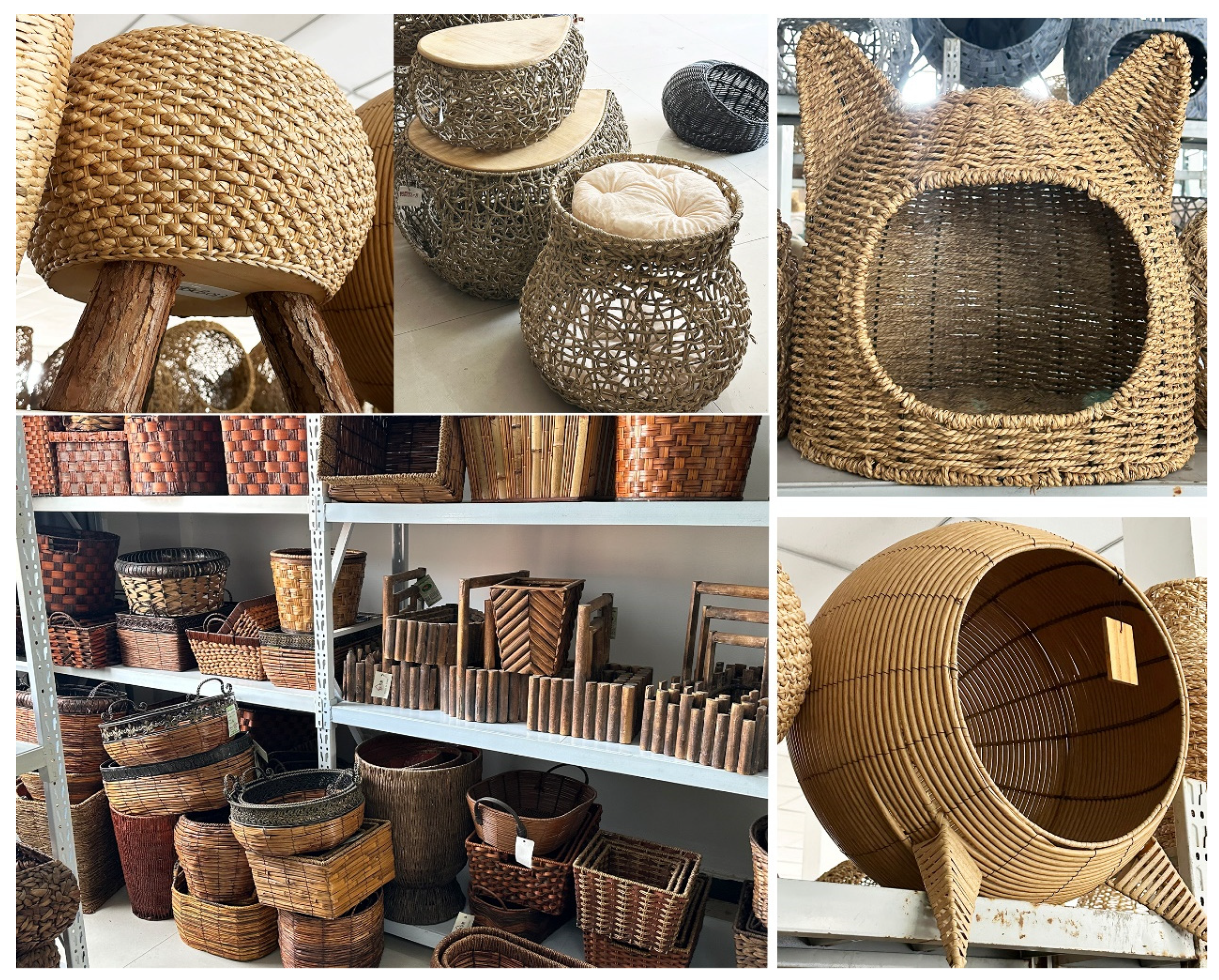
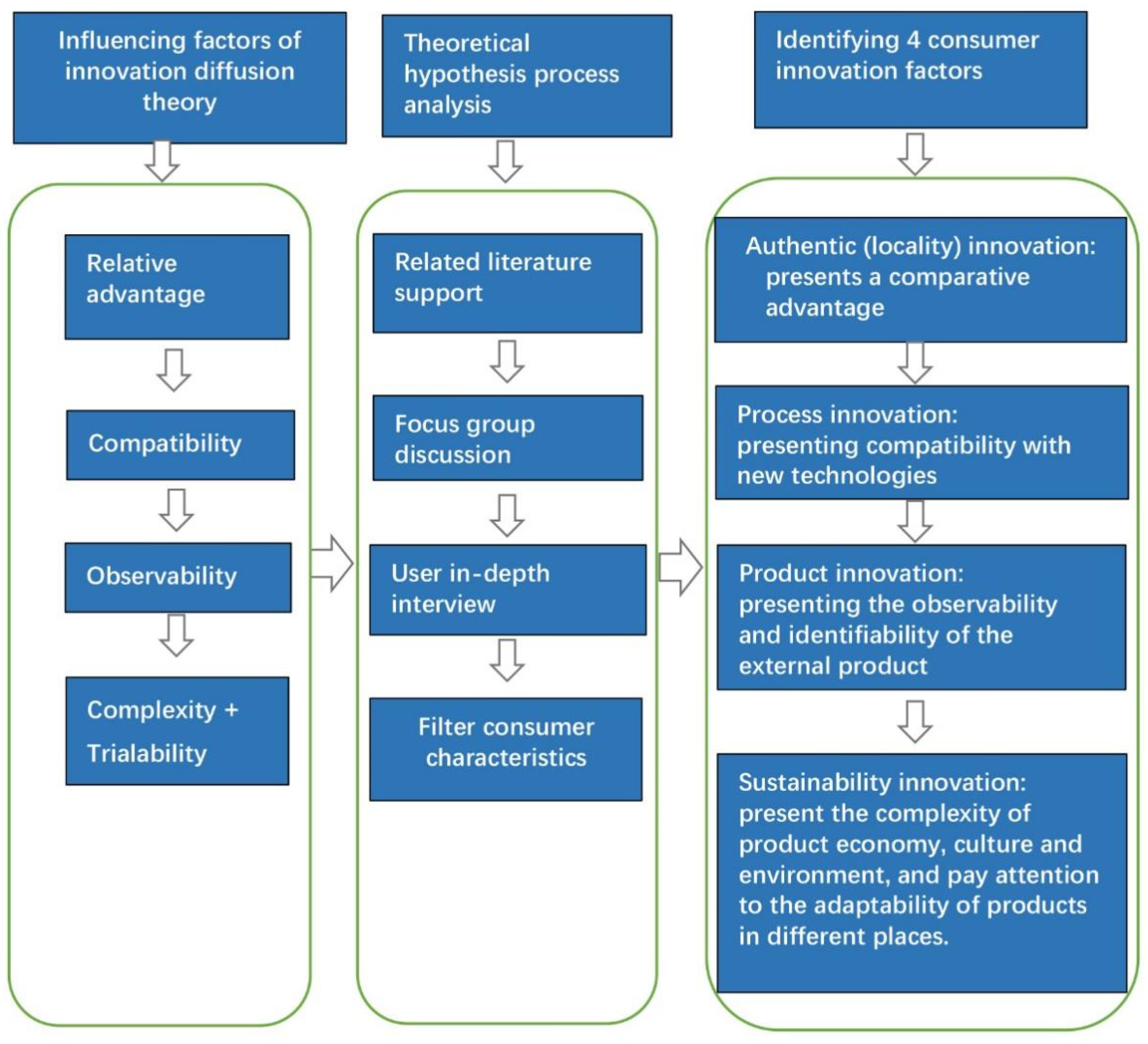

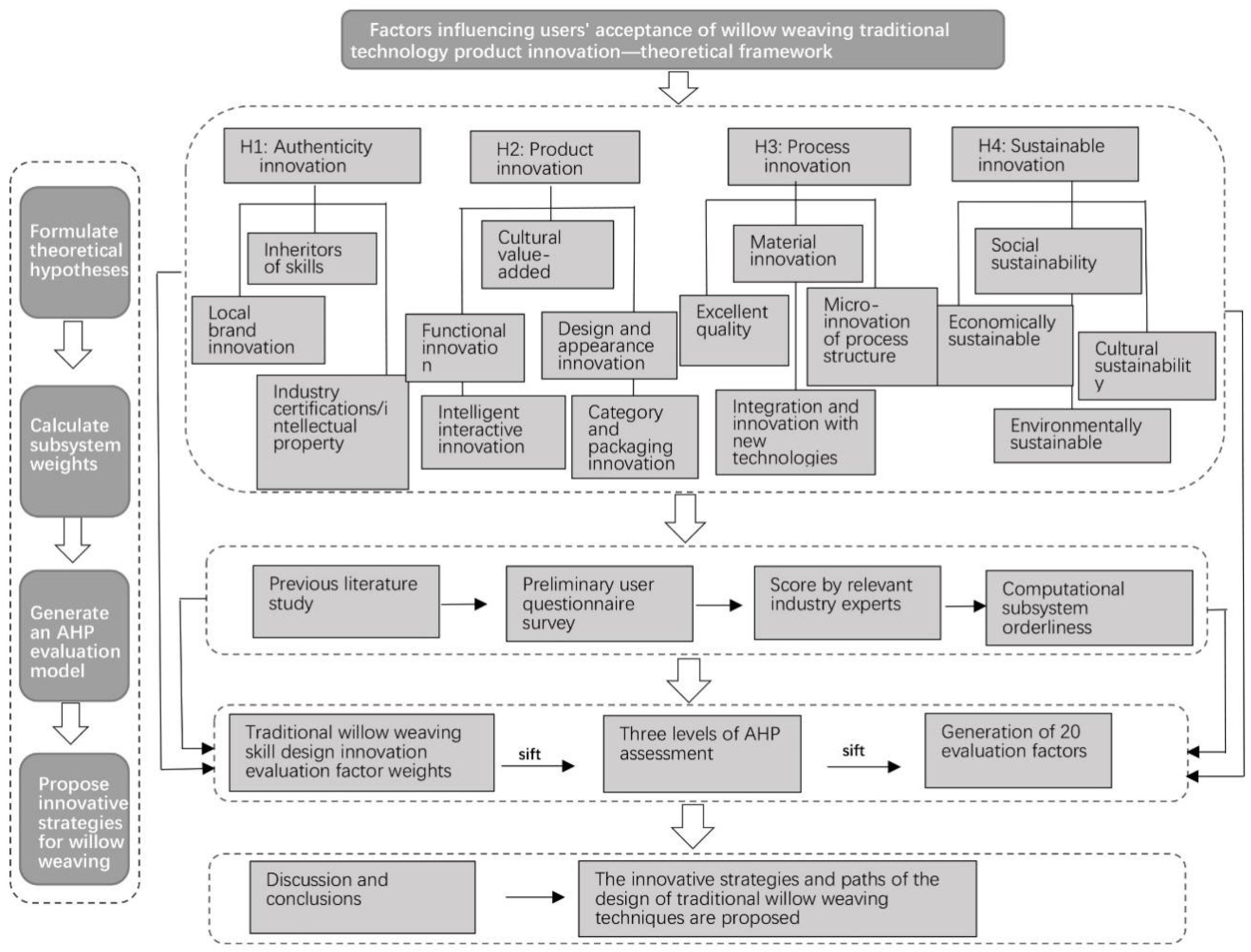
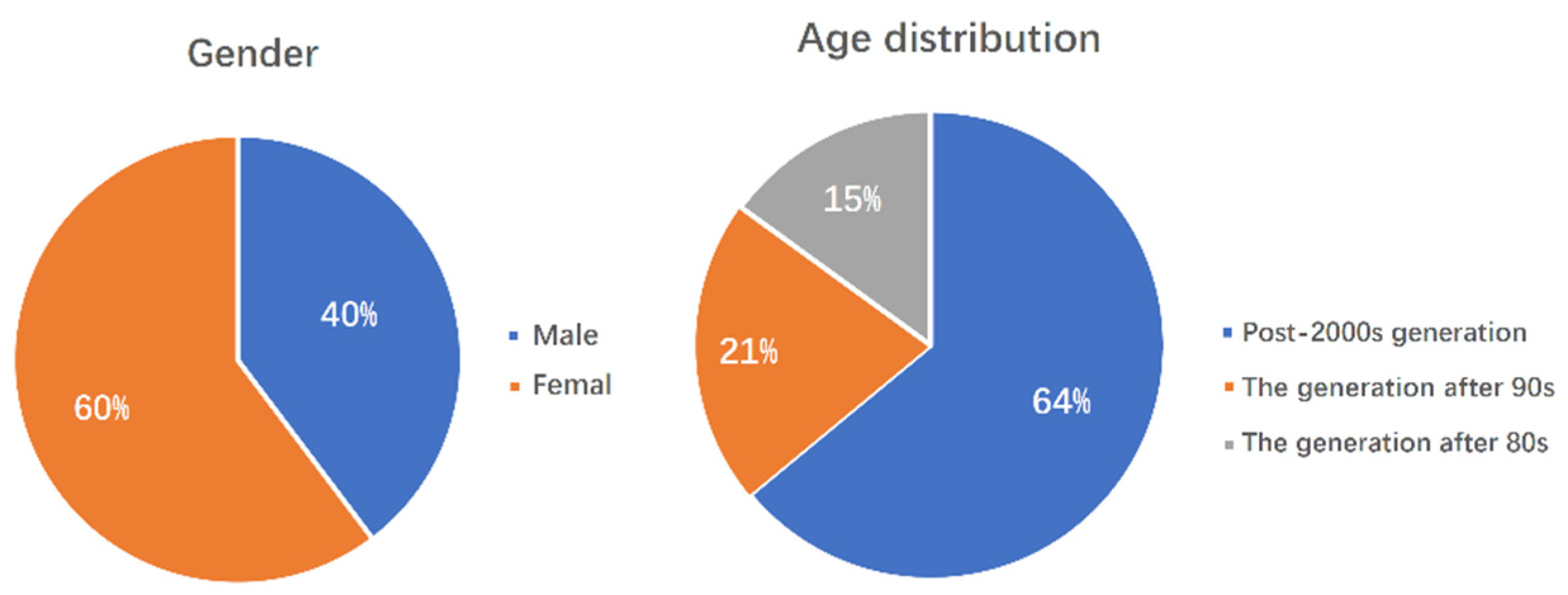

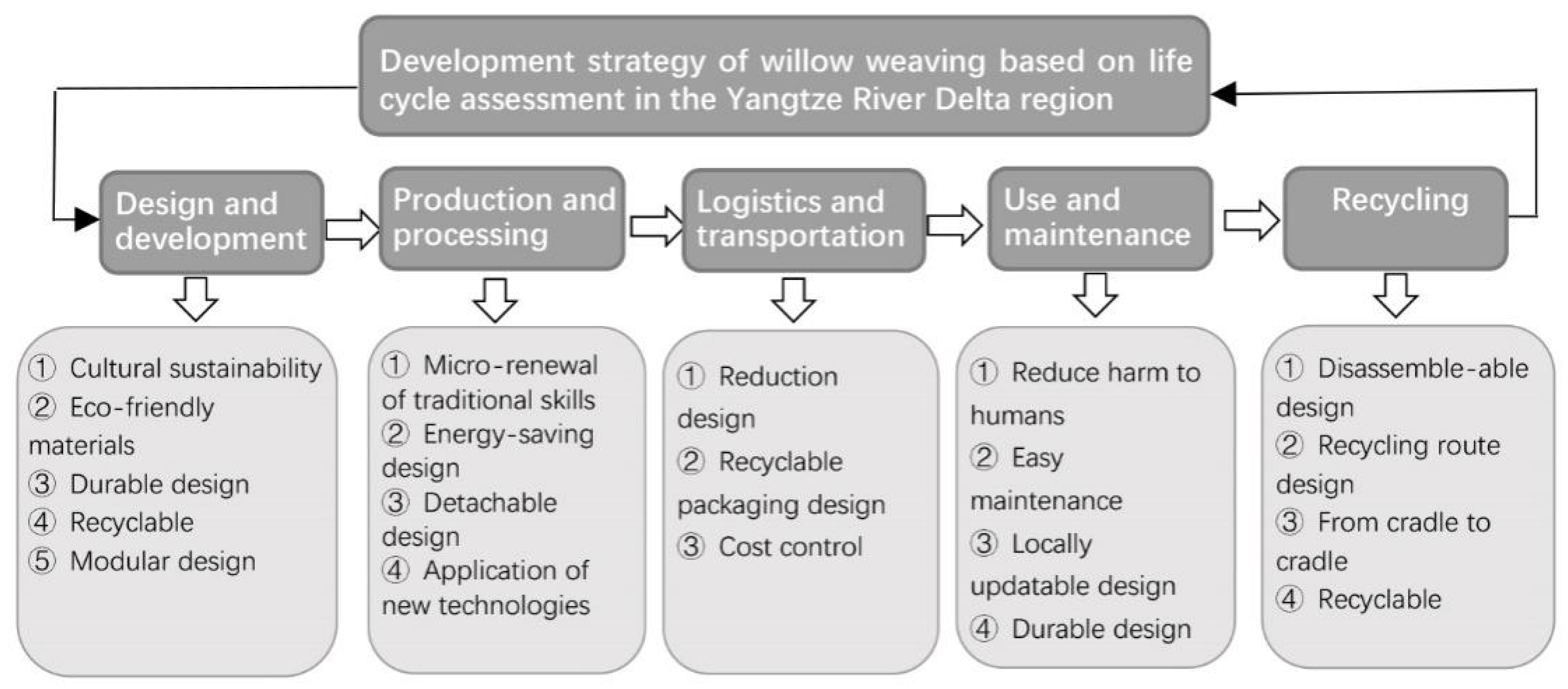
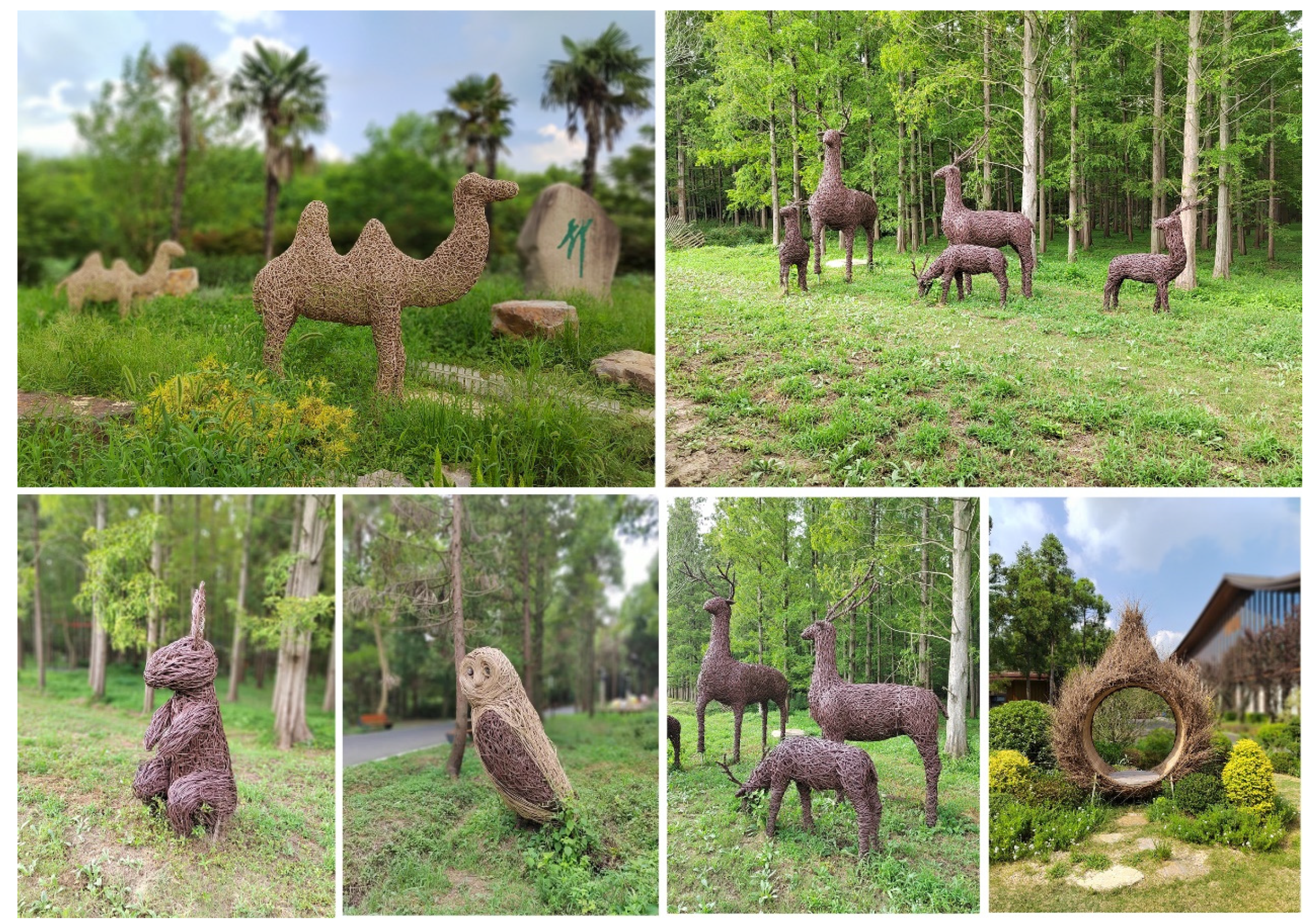
| Four Hypotheses | Hypothetical Factors | Corresponding Questionnaire Questions | Questionnaire Statistics |
|---|---|---|---|
| B1: Authenticity innovation | Local branding and label innovation of products | We think it is important to localize branding and label innovation for new products. Do you think this is important? | 1803 |
| Authentic innovation in artisan brand stories | We believe that willow weaving innovation should focus on “authentic innovation of the inheritor’s brand story”. Do you think this is important? | 1930 | |
| Authentic innovation in marketing | Do you think it is important that the marketing of our products should be consistent with the authenticity of the products? | 1904 | |
| Certification of relevant industries | Under the premise of a certain difference in price, are you more willing to buy a new product with industry certification? | 1726 | |
| Intellectual property rights (winning works of the design competition) | Under the premise of a certain difference in price, are you more willing to buy a willow weaving product with a design patent, with a utility model patent, or from a well-known domestic and international design competition? | 1720 | |
| B2: Product innovation | Category innovation | We believe that in addition to the willow weaving household category, we should develop more willow weaving public art, willow weaving architectural sketches, willow weaving public facilities, and willow weaving micro exhibition halls with regional characteristics to beautify the urban environment. Do you think this is important? | 1837 |
| Functional innovation | Do you think it is important that functional innovation in willow weaving products should lead to a new way of life? | 1831 | |
| Intelligent interactive innovation | We believe that the innovation of willow weaving products should have intelligent interaction functions and bring users a beautiful emotional experience. Do you think this is important? | 1836 | |
| Design and appearance innovation | We believe that the design innovation of willow weaving products should focus on the appearance and shape and should be in line with the aesthetic trend of the times. Do you think this is important? | 1867 | |
| Cultural value-added innovation | Do you think it is important that the innovation of willow weaving products should focus on cultural value-added innovation, such as integrating local culture with traditional willow weaving skills? | 1877 | |
| Packaging design innovation | Do you think the packaging design of new products is important? | 1829 | |
| B3: Process innovation | Adoption of high-quality original materials | Do you think it is important that high-quality willow weaving raw materials should be used for willow weaving process innovation? | 1926 |
| Integration and innovation of willow weaving materials and other mixed material processes | We believe that willow weaving products should consider the integration and innovation of willow woven materials with other hybrid materials. Do you think this is important? | 1837 | |
| Integration and innovation of traditional skills and new technologies | We believe that the innovation of willow weaving process should consider traditional skills and new technologies of convergent innovation. Do you think this is important? | 1887 | |
| Excellent quality, strong, and durable | We believe that the innovation of the willow weaving process must control the quality of the product—for example, the product must have a delicate edge closure, and it must be strong and durable. Do you think this is important? | 1941 | |
| Micro-innovation of process structure | Do you think it is important that the willow weaving process structure should be continuously micro-innovated according to the needs of users? | 1918 | |
| B4: Sustainable innovation | Economically sustainable (replacing hazardous materials with environmentally friendly/safe materials) | We believe that the materials of willow weaving products need to be environmentally friendly/safe replacing hazardous materials. Do you think this is important? | 1940 |
| Social sustainability (life cycle assessment (LCA) design) | We believe that willow woven products need to be designed from the perspective of LCA (LCA refers to the reasonable design of products in the five stages—design and development, manufacturing, use, maintenance, and recycling). Do you think this is important? | 1901 | |
| Environmentally sustainable (products can be recycled or naturally degraded) | Do you think it is important that willow weaving products should be made with minimal material use and recyclable or naturally degradable materials? | 1935 | |
| Cultural sustainability (transmission and inheritance of willow weaving traditional skills and culture) | We think willow weaving product innovation should promote the spread of traditional culture and have a positive impact on the inheritance of intangible cultural heritage skills. Do you think this is important? | 1945 |
| Target Layer A | Criterion Level B | Factor Layer C |
|---|---|---|
| A: Evaluation of the influencing factors of consumers’ acceptance of the design innovation of willow weaving traditional techniques | B1: Authenticity innovation | C1: Local brand and label innovation of products |
| C2: Authentic innovation in artisan brand stories | ||
| C3: Authentic innovation in marketing | ||
| C4: Certification of relevant industries | ||
| C5: Intellectual property rights (winning works from design competitions) | ||
| B2: Product innovation | C6: Category innovation | |
| C7: Functional innovation | ||
| C8: Intelligent interactive innovation | ||
| C9: Design and appearance innovation | ||
| C10: Cultural value-added innovation | ||
| C11: Packaging design innovation | ||
| B3: Process innovation | C12: Adoption of high-quality original materials | |
| C13: Integration and innovation of willow weaving materials and other mixed material processes | ||
| C14: Integration and innovation of traditional skills and new technologies | ||
| C15: Excellent quality, strong, and durable | ||
| C16: Micro-innovation of process structure | ||
| B4: Sustainable innovation | C17: Economically sustainable (replacing hazardous materials with environmentally friendly/safe materials) | |
| C18: Social sustainability (life cycle assessment design) | ||
| C19: Environmentally sustainable (products can be recycled or naturally degraded) | ||
| C20: Cultural sustainability (transmission and inheritance of willow weaving traditional skills and culture) |
| Aij | Definition | Aij | Definition |
|---|---|---|---|
| 1 | Ai is as important as Aj | 2 | Somewhere between equally and slightly important |
| 3 | Ai is slightly more important than Aj | 4 | Somewhere between slightly and obviously important |
| 5 | Ai is significantly more important than Aj | 6 | Between obviously and very obviously important |
| 7 | Ai is obviously more important than Aj | 8 | Somewhere between obviously and absolutely important |
| 9 | Ai is absolutely more important than Aj | reciprocal | Aij is the importance comparison of indicators i and j, aij = 1/aji |
| Evaluation Indicators | B1: Authentic Innovation | B2: Product Innovation | B3: Process Innovation | B4: Sustainable Innovation | Wi |
|---|---|---|---|---|---|
| B1: Authentic innovation | 1 | 1/2 | 1/2 | 1/3 | 0.1162 |
| B2: Product innovation | 2 | 1 | 1 | 1/3 | 0.1954 |
| B3: Process innovation | 2 | 1 | 1 | 1/3 | 0.1954 |
| B4: Sustainable innovation | 3 | 3 | 3 | 1 | 0.4930 |
| Evaluation Indicators | C1: Local Brand and Label Innovation of Products | C2: Authentic Innovation in Artisan Brand Stories | C3: Authentic Innovation in Marketing | C4: Certification of Relevant Industries | C5: Intellectual Property Rights (Winning Works of the Design Competition) | Wi |
|---|---|---|---|---|---|---|
| C1: Local branding and label innovation of products | 1 | 1/2 | 1/2 | 2 | 2 | 0.1660 |
| C2: Authentic innovation in artisan brand stories | 2 | 1 | 1/2 | 3 | 5 | 0.2853 |
| C3: Authentic innovation in marketing | 2 | 2 | 1 | 4 | 4 | 0.3814 |
| C4: Certification of relevant industries | 1/2 | 1/3 | 1/4 | 1 | 1 | 0.0879 |
| C5: Intellectual property rights (winning works from design competitions) | 1/2 | 1/5 | 1/4 | 1 | 1 | 0.0794 |
| Evaluation Indicators | C6: Category Innovation | C7: Functional Innovation | C8: Intelligent Interactive Innovation | C9: Design and Appearance Innovation | C10: Cultural Value-Added Innovation | C11: Packaging Design Innovation | Wi |
|---|---|---|---|---|---|---|---|
| C6: Category innovation | 1 | 2 | 2 | 1/2 | 1/2 | 2 | 0.1733 |
| C7: Functional innovation | 1/2 | 1 | 1/2 | 1/2 | 1/2 | 2 | 0.1092 |
| C8: Intelligent interactive innovation | 1/2 | 2 | 1 | 1/2 | 1/2 | 2 | 0.1375 |
| C9: Design and appearance innovation | 2 | 2 | 2 | 1 | 1/2 | 2 | 0.2183 |
| C10: Cultural value-added innovation | 2 | 2 | 2 | 2 | 1 | 2 | 0.2751 |
| C11: Packaging design innovation | 1/2 | 1/2 | 1/2 | 1/2 | 1/2 | 1 | 0.0866 |
| Evaluation Indicators | C12: Adoption of High-Quality Original Materials | C13: Integration and Innovation of Willow Weaving Materials and Other Mixed Material Processes | C14: Integration and Innovation of Traditional Skills and New Technologies | C15: Excellent Quality, Strong, and Durable | C16: Micro-Innovation of Process Structure | Wi |
|---|---|---|---|---|---|---|
| C12: Adoption of high-quality original materials | 1 | 2 | 2 | 1/2 | 2 | 0.2447 |
| C13: Integration and innovation of willow weaving materials and other mixed material processes | 1/2 | 1 | 1/2 | 1/2 | 1/2 | 0.1065 |
| C14: Integration and innovation of traditional skills and new technologies | 1/2 | 2 | 1 | 1/2 | 1/2 | 0.1405 |
| C15: Excellent quality, strong, and durable | 2 | 2 | 2 | 1 | 2 | 0.3229 |
| C16: Micro-innovation of process structure | 1/2 | 2 | 2 | 1/2 | 1 | 0.1854 |
| Evaluation Indicators | C17: Economically Sustainable (Replacing Hazardous Materials with Environmentally Friendly/Safe Materials) | C18: Social Sustainability (Life Cycle Assessment Design) | C19: Environmentally Sustainable (Products Can Be Recycled or Naturally Degraded) | C20: Cultural Sustainability (Transmission and Inheritance of Willow Weaving Traditional Skills and Culture) | Wi |
|---|---|---|---|---|---|
| C17: Economically sustainable (replacing hazardous materials with environmentally friendly/safe materials) | 1 | 2 | 2 | 1/2 | 0.2383 |
| C18: Social sustainability (life cycle assessment design) | 1/2 | 1 | 1/2 | 1/5 | 0.0948 |
| C19: Environmentally sustainable (products can be recycled or naturally degraded) | 1/2 | 2 | 1 | 1/5 | 0.1340 |
| C20: Cultural sustainability (transmission and inheritance of willow weaving traditional skills and culture) | 2 | 5 | 5 | 1 | 0.5329 |
| Criterion Level | Relative Weight | Factor Layer | Relative Weight | Absolute Weight | Sort |
|---|---|---|---|---|---|
| B1: Authenticity innovation | 0.116195 | C1: Local brand and label innovation of products | 0.166004 | 0.019289 | 17 |
| C2: Authentic innovation in artisan brand stories | 0.285323 | 0.033153 | 12 | ||
| C3: Authentic innovation in marketing | 0.381377 | 0.044314 | 8 | ||
| C4: Certification of relevant industries | 0.087918 | 0.010216 | 19 | ||
| C5: Intellectual property rights (winning works from design competitions) | 0.079379 | 0.009223 | 20 | ||
| B2: Product innovation | 0.195416 | C6: Category innovation | 0.173281 | 0.033862 | 11 |
| C7: Functional innovation | 0.10916 | 0.021332 | 15 | ||
| C8: Intelligent interactive innovation | 0.137533 | 0.026876 | 14 | ||
| C9: Design and appearance innovation | 0.21832 | 0.042663 | 9 | ||
| C10: Cultural value-added innovation | 0.275066 | 0.053752 | 5 | ||
| C11: Packaging design innovation | 0.08664 | 0.016931 | 18 | ||
| B3: Process innovation | 0.195416 | C12: Adoption of high-quality original materials | 0.244679 | 0.047814 | 6 |
| C13: Integration and innovation of willow weaving materials and other mixed material processes | 0.106503 | 0.020812 | 16 | ||
| C14: Integration and innovation of traditional skills and new technologies | 0.140531 | 0.027462 | 13 | ||
| C15: Excellent quality, strong, and durable | 0.322856 | 0.063091 | 4 | ||
| C16: Micro-innovation of process structure | 0.185432 | 0.036236 | 10 | ||
| B4: Sustainable innovation | 0.492973 | C17: Economically sustainable (replacing hazardous materials with environmentally friendly/safe materials) | 0.23832 | 0.117485 | 2 |
| C18: Social sustainability (life cycle assessment design) | 0.094764 | 0.046716 | 7 | ||
| C19: Environmentally sustainable (products can be recycled or naturally degraded) | 0.134017 | 0.066067 | 3 | ||
| C20: Cultural sustainability (transmission and inheritance of willow weaving traditional skills and culture) | 0.532899 | 0.262705 | 1 |
Disclaimer/Publisher’s Note: The statements, opinions and data contained in all publications are solely those of the individual author(s) and contributor(s) and not of MDPI and/or the editor(s). MDPI and/or the editor(s) disclaim responsibility for any injury to people or property resulting from any ideas, methods, instructions or products referred to in the content. |
© 2023 by the authors. Licensee MDPI, Basel, Switzerland. This article is an open access article distributed under the terms and conditions of the Creative Commons Attribution (CC BY) license (https://creativecommons.org/licenses/by/4.0/).
Share and Cite
Sun, N.; He, Y.; Wang, C.; Zhang, J. Research on Sustainable Design of Consumers’ Influence Factors of Huaihe Willow Weaving Based on AHP. Sustainability 2023, 15, 11115. https://doi.org/10.3390/su151411115
Sun N, He Y, Wang C, Zhang J. Research on Sustainable Design of Consumers’ Influence Factors of Huaihe Willow Weaving Based on AHP. Sustainability. 2023; 15(14):11115. https://doi.org/10.3390/su151411115
Chicago/Turabian StyleSun, Nameng, You He, Chang Wang, and Junxue Zhang. 2023. "Research on Sustainable Design of Consumers’ Influence Factors of Huaihe Willow Weaving Based on AHP" Sustainability 15, no. 14: 11115. https://doi.org/10.3390/su151411115
APA StyleSun, N., He, Y., Wang, C., & Zhang, J. (2023). Research on Sustainable Design of Consumers’ Influence Factors of Huaihe Willow Weaving Based on AHP. Sustainability, 15(14), 11115. https://doi.org/10.3390/su151411115








